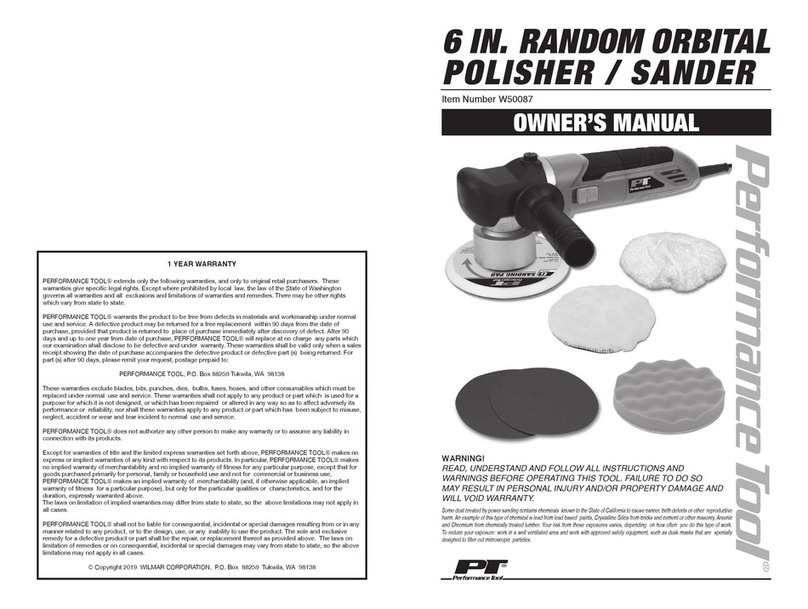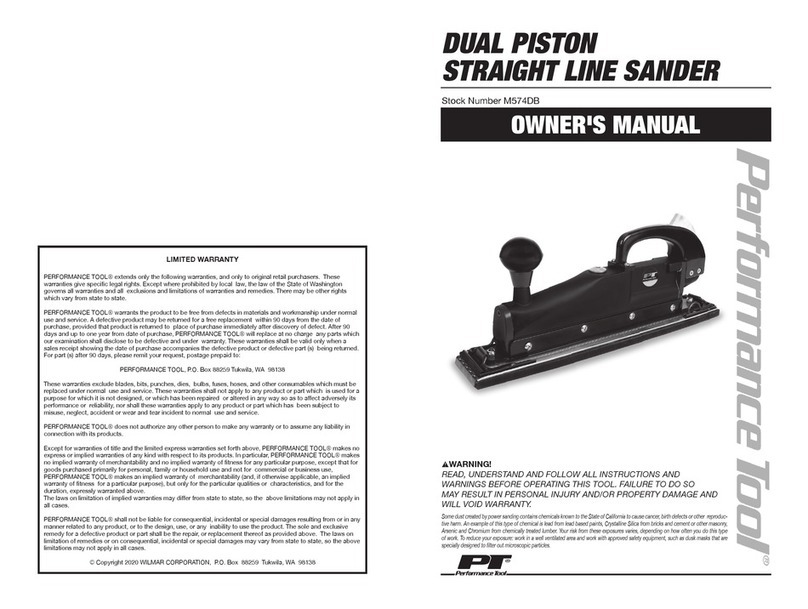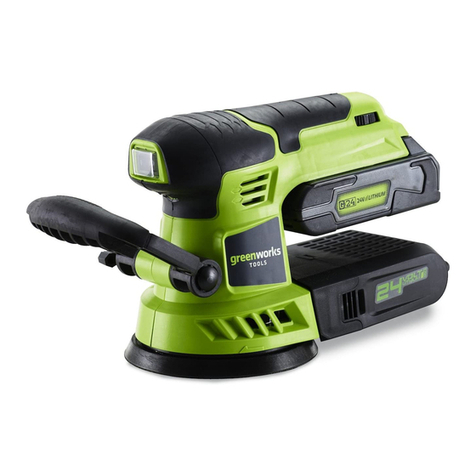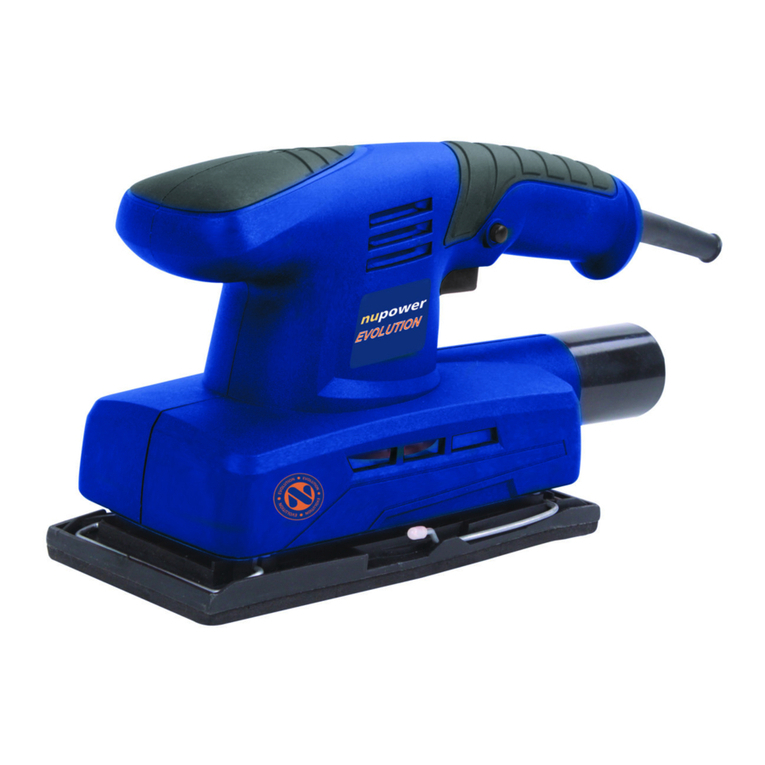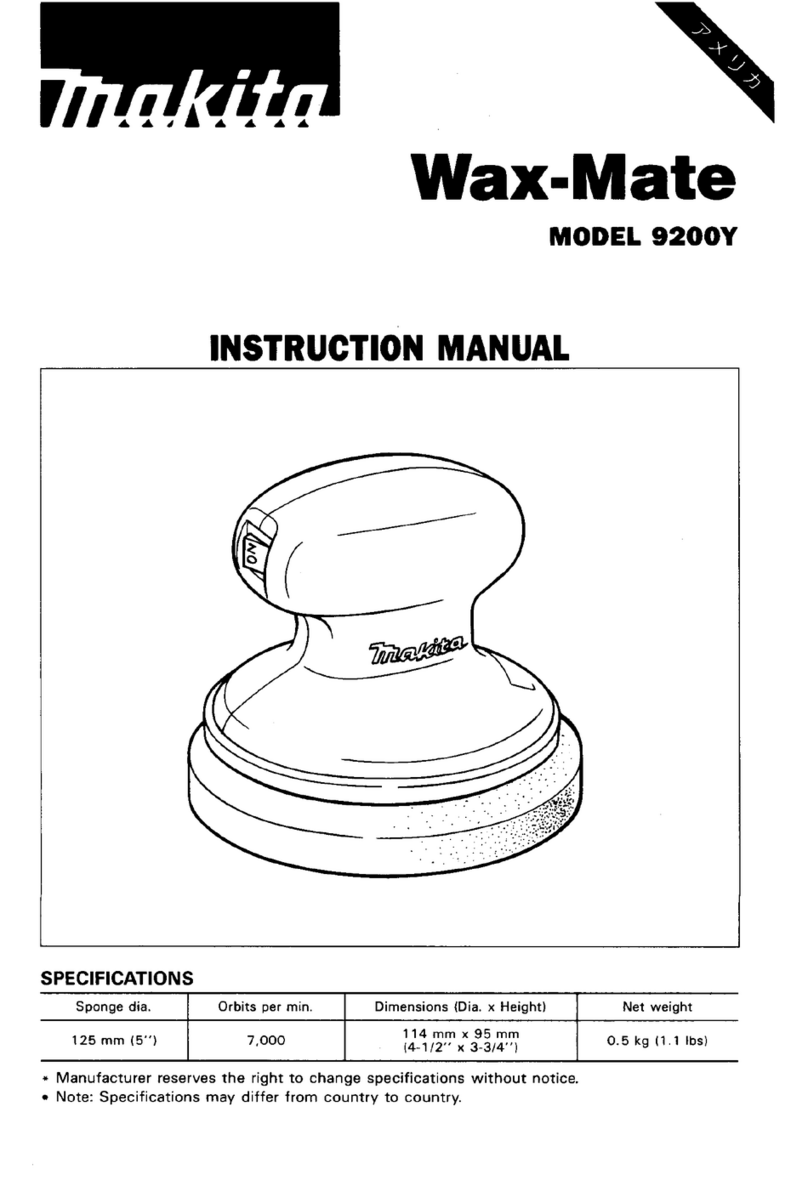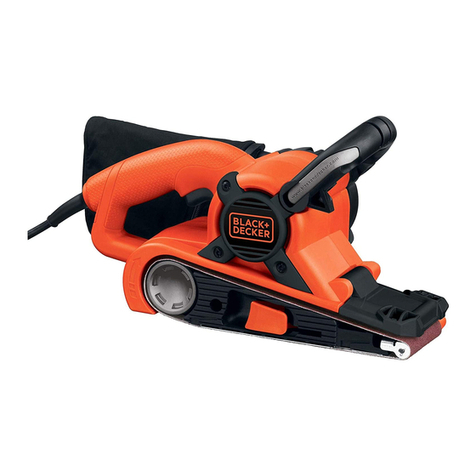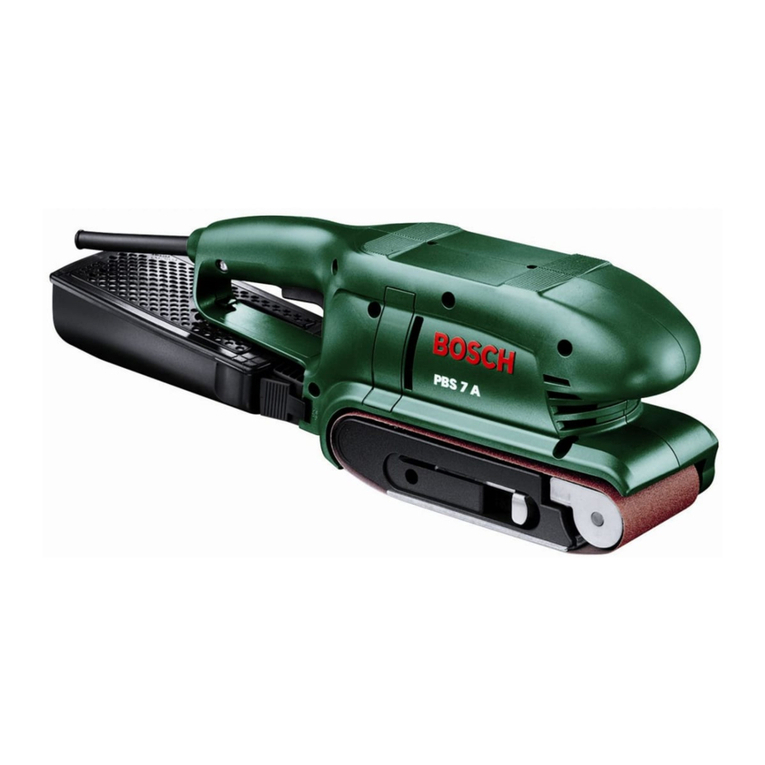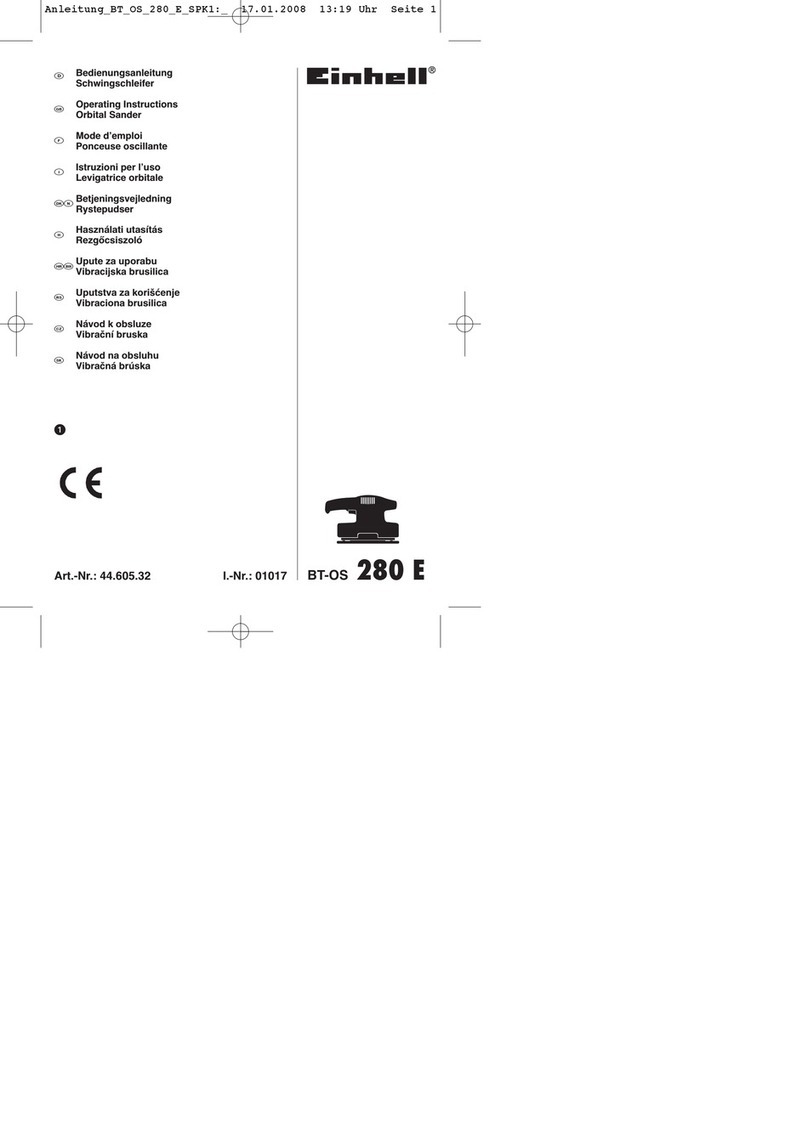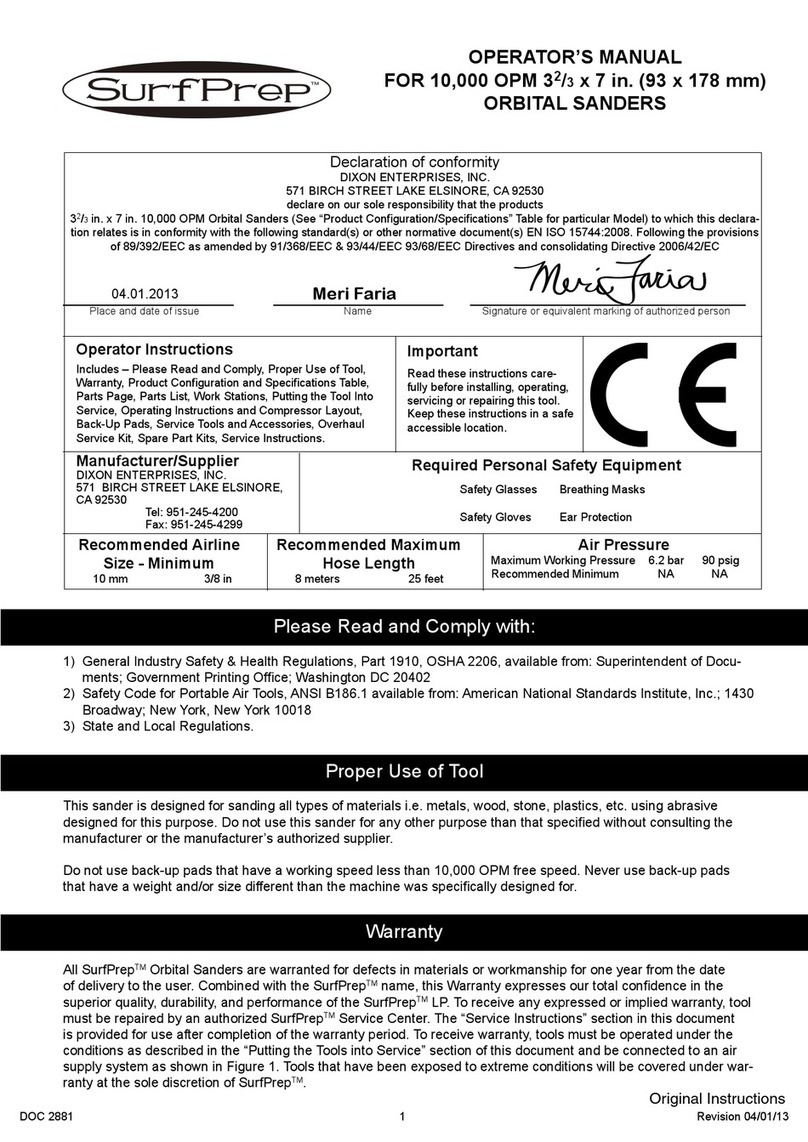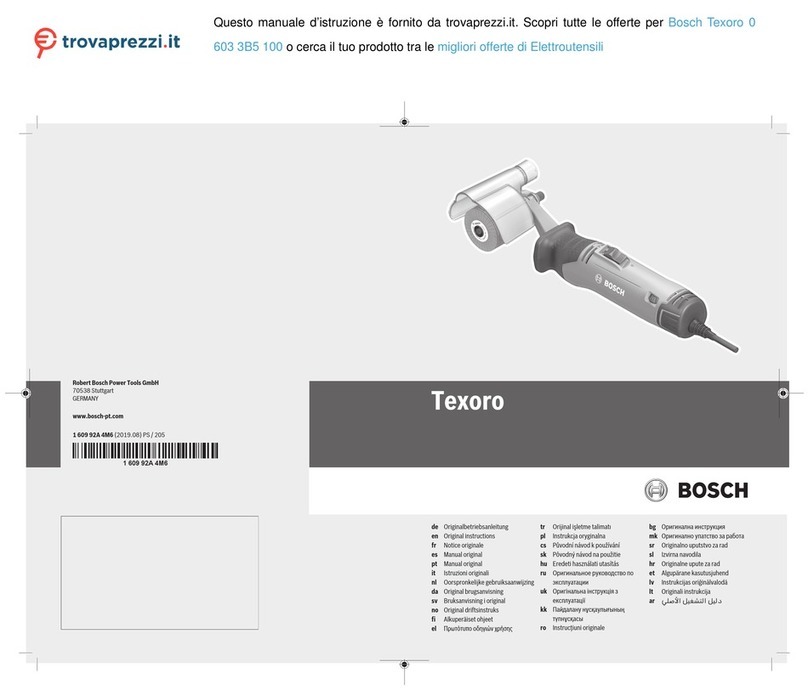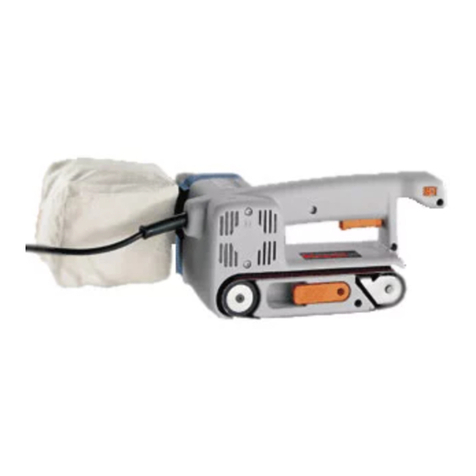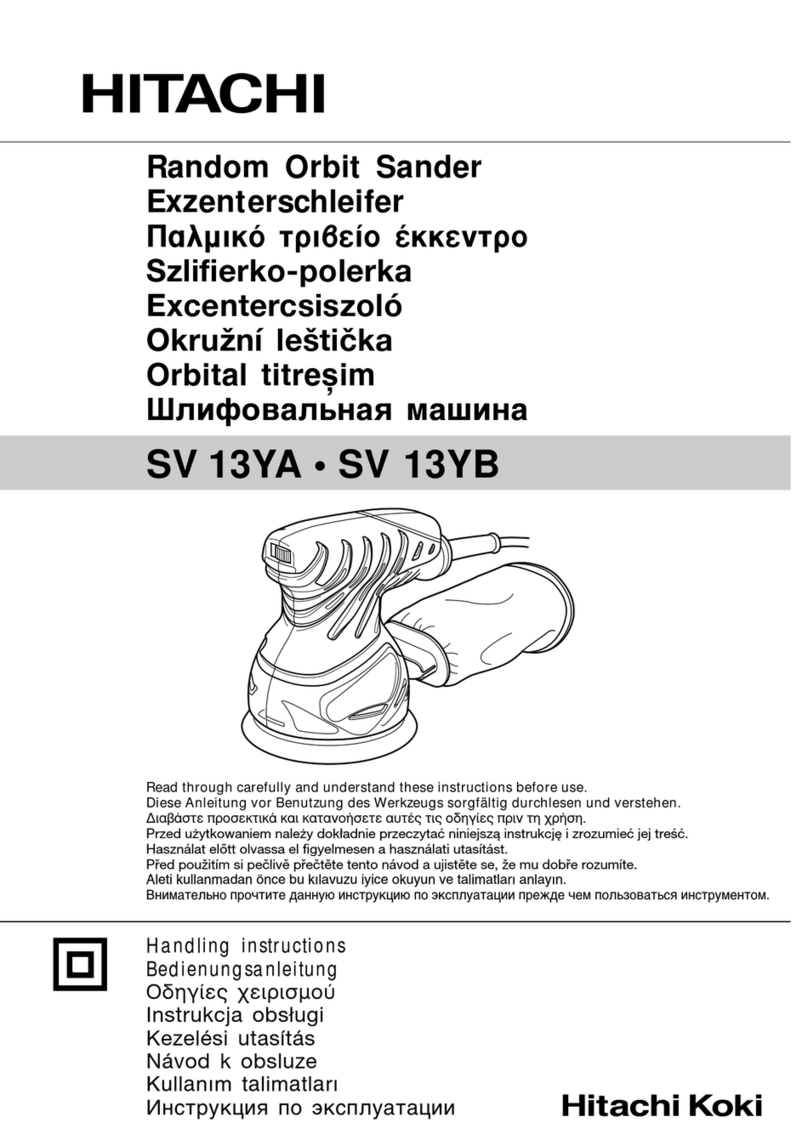PT M568DB User manual

WARNING!
READ, UNDERSTAND AND FOLLOW ALL INSTRUCTIONS AND
WARNINGS BEFORE OPERATING THIS TOOL. FAILURE TO DO SO
MAY RESULT IN PERSONAL INJURY AND/OR PROPERTY DAMAGE AND
WILL VOID WARRANTY.
Some dust created by power sanding contains chemicals known to the State of California to cause cancer, birth defects or other re-
productive harm. An example of this type of chemical is lead from lead based paints, Crystalline Silica from bricks and cement or other
masonry, Arsenic and Chromium from chemically treated lumber. Your risk from these exposures varies, depending on how often you do
this type of work. To reduce your exposure: work in a well ventilated area and work with approved safety equipment, such as dusk masks
that are specially designed to lter out microscopic particles.
6" DUAL ACTION AIR SANDER
OWNER’S MANUAL
Stock Number M568DB
SPECIFICATIONS:
Pad size.......................................................................................... 6 in.
Sanding surface ...............................................................28-1/4 sq. in.
Spindle/thread size.....................................................5/16 in. / 24 UNF
Orbital stroke ............................................................................ 5/16 in.
Air pressure .............................................................................. 90 P.S.I.
Average air consumption .........................................................5 C.F.M.
Free speed.......................................................................10,000 R.P.M.
Air inlet............................................................................... 1/4 in. N.P.T.
Recommended hose size......................................................3/8 in. I.D.
Length ......................................................................................... 8.6 in.
Weight ....................................................................................... 3.3 lbs.
Specifications are subject to change without notice.
1 YEAR LIMITED WARRANTY
PERFORMANCE TOOL® extends only the following warranties, and only to original
retail purchasers. These warranties give specific legal rights. Except where prohibited
by local law, the law of the State of Washington governs all warranties and all
exclusions and limitations of warranties and remedies. There may be other rights which
vary from state to state.
PERFORMANCE TOOL® warrants the product to be free from defects in materials and
workmanship under normal use and service. A defective product may be returned for a
free replacement within 90 days from the date of purchase, provided that product is
returned to place of purchase immediately after discovery of defect. After 90 days and
up to one year from date of purchase, PERFORMANCE TOOL® will replace at no
charge any parts which our examination shall disclose to be defective and under
warranty. These warranties shall be valid only when a sales receipt showing the date of
purchase accompanies the defective product or defective part(s) being returned. For
part(s) after 90 days, please remit your request, postage prepaid to:
PERFORMANCE TOOL, P.O. Box 88259 Tukwila, WA 98138
These warranties exclude blades, bits, punches, dies, bulbs, fuses, hoses, and other
consumables which must be replaced under normal use and service. These warranties
shall not apply to any product or part which is used for a purpose for which it is not
designed, or which has been repaired or altered in any way so as to affect adversely its
performance or reliability, nor shall these warranties apply to any product or part which
has been subject to misuse, neglect, accident or wear and tear incident to normal use
and service.
PERFORMANCE TOOL® does not authorize any other person to make any warranty or
to assume any liability in connection with its products.
Except for warranties of title and the limited express warranties set forth above,
PERFORMANCE TOOL® makes no express or implied warranties of any kind with
respect to its products. In particular, PERFORMANCE TOOL® makes no implied
warranty of merchantability and no implied warranty of fitness for any particular
purpose, except that for goods purchased primarily for personal, family or household
use and not for commercial or business use, PERFORMANCE TOOL® makes an
implied warranty of merchantability (and, if otherwise applicable, an implied warranty of
fitness for a particular purpose), but only for the particular qualities or characteristics,
and for the duration, expressly warranted above. The laws on limitation of implied
warranties may differ from state to state, so the above limitations may not apply in all
cases.
PERFORMANCE TOOL® shall not be liable for consequential, incidental or special
damages resulting from or in any manner related to any product, or to the design, use,
or any inability to use the product. The sole and exclusive remedy for a defective
product or part shall be the repair, or replacement thereof as provided above. The laws
on limitation of remedies or on consequential, incidental or special damages may vary
from state to state, so the above limitations may not apply in all cases.
© Copyright 2018 WILMAR CORPORATION, P.O. Box 88259 Tukwila, WA 98138

1 2
IMPORTANT SAFETY INFORMATION
1. Keep work area clean. Cluttered areas invite injuries.
2. Observe work area conditions. Do not use machines or power tools in damp or wet
locations. Don’t expose to rain. Keep work area well lighted. Do not use electrically
powered tools in the presence of flammable gases or liquids. Do not bring combustible
materials near the tools.
3. As with any tool, use common sense when operating. Do not wear loose clothing or jewelry
that could become caught by moving parts, causing injury. Operate tool a safe distance
from yourself and others in the work area.
4. Keep children away. Children must never be allowed in the work area. Do not let them
handle machines, tools, hoses or extension cords.
5. Store idle equipment. When not in use, tools must be stored in a dry location to inhibit rust.
Always lock up tools and keep out of reach of children and other untrained persons. Switch
off all unused electrical tools when stored. Tools are dangerous in the hands of untrained
users.
6. Always wear approved eye protection when using tools. If raising dust, wear a suitable
mask.
7. Work Safe. When wearing gloves to operate the tool, make sure that the gloves do
not
interfere with operating the Trigger. Test your gloves with the Trigger before attaching the unit
to an air source. Keep your finger away from the Trigger until you are ready to work. Never
start the tool unless you have a firm grip with both hands and you are positioned at your
work piece or area. Before using the tool, know what is directly underneath the work area or
work piece. The tool can quickly penetrate material. If working directly on the ground, make
sure you are not directly above shallow cables, lines, or pipes. Keep your limbs and body
clear of the tool. If an accessory or attachment breaks off, the tool tends to surge forward
suddenly. Operate tool a safe distance from yourself and others in the work area. Make sure
the immediate area is clear of other people or animals. Spectators must stay at a safe
distance. Never point the tool or the air hose (not included) at anyone. Keep proper footing
and balance at all times. Do not reach over or across running machines, hoses, etc.
8. Do not operate any tool if under the influence of alcohol or drugs. Read warning labels on
prescriptions to determine if your judgment or reflexes are impaired while taking drugs. If
there is any doubt, do not operate any tool.
9. Be sure air is in OFF position when connecting tool to air supply.
10. Use only those accessories that are designed for use with tools. For example, with impact
wrenches do not use ordinary sockets. Use impact sockets for all air tools.
11. Be sure to disconnect tool from air supply before changing accessories, performing service
on tool and when not in use.
12. Follow air source manufacturers' directions for connection of regulators, filters, and other
accessories to air source. Do not install quick couplers directly on tool as they put
unnecessary strain on the air inlet threads possibly causing them to wear out prematurely.
Instead, install them on a short length of air hose attached to the tool.
13. Check for damaged parts. Before using any tool, any part that appears damaged
should be
carefully checked to determine that it will operate properly and perform its intended
function. Check for alignment and binding of moving parts; any broken parts or mounting
fixtures; and any other condition that may affect proper operation. Any part that is damaged
should be properly repaired or replaced by a qualified technician.
WARNING!
READ, UNDERSTAND AND FOLLOW ALL INSTRUCTIONS AND
WARNINGS BEFORE OPERATING THIS TOOL. FAILURE TO DO
SO MAY RESULT IN PERSONAL INJURY AND/OR PROPERTY
DAMAGE AND WILL VOID WARRANTY.
IMPORTANT SAFETY INFORMATION
ASSEMBLY / INSTALLATION
1.
You will need to prepare the 1/4" Quick-disconnect Coupler Plug to connect to the air inlet
on the sander. Wrap the Coupler Plug with pipe thread seal tape before threading it into the
Air Inlet. Connect the a Quick-Disconnect coupler on a 3/8" ID Air Source Hose to the tool.
Note: If you are not using an automatic oiler system, before operation, add a few drops of
Pneumatic Tool Oil to the airline connection. Add a few drops more after each hour of
continual use.
2. Set the air pressure on your compressor to 90 PSI. Do not exceed the recommended air
pressure of 90 PSI.
3. Check the air connection for leaks. Once you are satisfied there are no leaks, turn off
the air compressor and disconnect the tool.
14. Maintenance. For your safety, maintenance should be performed regularly by a qualified
technician using original PERFORMANCE TOOLS® replacement parts. Failure to do so can
lead to accidents for the operator. Use of any other parts will void the warranty. Only use
accessories intended for use with this tool. Approved accessories are available from
Performance Tool®. Use only accessories that are recommended by the manufacturer for
your model. Accessories that may be suitable for one tool may become hazardous when
used on another tool.
Some dust created by power sanding contains chemicals known to the State of California to cause cancer,
birth defects or other reproductive harm. An example of this type of chemical is lead from lead based paints,
Crystalline Silica from bricks and cement or other masonry, Arsenic and Chromium from chemically treated
lumber. Your risk from these exposures varies, depending on how often you do this type of work. To reduce
your exposure: work in a well ventilated area and work with approved safety equipment, such as dusk masks
that are specially designed to filter out microscopic particles.
WARNING:
Repetitive motions or exposure to vibration may be harmful to your hands and arms.
WARNING: WARNING: Cancer and Reproductive Harm – www.P65Warnings.ca.gov.
WARNING:
The warnings, cautions, and instructions discussed in this instruction manual cannot cover all
possible conditions and situations that may occur. It must be understood by the operator that common sense
and caution are factors which cannot be built into this product, but must be supplied by the operator. Read and
understand all of the instructions provided in the instruction manual of this product, as well as, any other tool
(s) used with this product.
1. Disconnect the air hose from the tool.
2. Select the appropriate Sanding Pad (not included), and press it onto the Backing Pad.
Firmly press the Sanding Pad onto the Backing Pad, making certain it is securely in
place. Failure to properly secure the Sanding Pad may cause the Sanding Pad to come
loose, possibly causing personal injury or property damage.
INSTALLING THE SANDING PAD
1. Disconnect tool from air supply.
2. Slide Wrench under Cover and onto the Arbor. Holding the wrench firmly, rotate Arbor
counterclockwise to remove.
3. To replace the Backing Pad, place wrench onto Arbor and hold firmly.
4. Place Backing Pad onto Arbor and turn clockwise to attach. Hand tighten firmly.
INSTALLING THE BACKING PAD

3 4
AIR SOURCE
Clean air of correct air pressure is recommended for the power supply
for this tool. A maximum of 90 PSI at the tool is recommended for most
air tools of this class. Check specifications section for recommended
pressure. (Depending on length of air hose and other circumstances, air
pressure at compressor may need to be increased to 100 PSI to ensure
90 PSI at the tool.)
Water in the air hose and compressor tank contributes to reduced
performance and damage of the air tool. Drain the air tank and filters
before each use and as necessary to keep the air supply dry.
Hose length over 25’ causes loss in line pressure. Increase hose I.D. or
increase compressor pressure to compensate for the pressure loss. Use
an in-line pressure regulator with gauge if air inlet pressure is critical.
OPERATION
1. Regulate pad speed with air regulator knob.
2. Start the sander off the sanding surface. Set the sander on the
surface gently and evenly and start the work. Let the sander do the
work. The weight of the sander will provide efficient sanding.
Applying pressure to the sander will only slow the speed of the pad
and reduce sanding efficiency. This will also overload the motor and
cause premature wear of the tool and void the warranty.
3. Work the sander back and forth in a wide, overlapping motion. Lift
the sander off the surface before releasing the trigger.
4.
Start with a paper grit coarse enough to remove high spots and rough
areas. Continue using progressively finer grit to attain desired finish.
Sanding pad
Air regulator
Trigger
Air Inlet
Motor
Oil
Trans.
Fluid
Brake
Fluid
Water
Whip
hose
Air Tool
Oil
YesNo
Oil tool before each use. 4 to 5 drops of a good grade Air Tool
Oil placed in the air inlet is sufficient. Use proper air pressure and
CFM rating listed for this tool.
Drain water from hoses and compressor tank. Water in the
air supply line will cause gumming and loss of power. Clean the
air lter on the supply line and ush the tool with gum solvent or
a 50/50 mix of air tool oil and kerosene. It may be necessary to
disassemble the tool to properly clean and re-lubricate.
LUBRICATION & MAINTENANCE
TROUBLESHOOTING
INSUFFICIENT POWER:
Probable Cause Solution
Dirty or clogged air passages......... Flush and lubricate tool, drain air tank and supply line
Insufficient air supply...................... Increase line pressure, Make sure compressor
matches tool’s air pressure and consumption needs
Air leakage...................................... Use teflon tape at all fittings and joints. Check tool for
worn or damaged O-rings & seals.
Worn/damaged wear & tear parts .. Replace as necessary.
Tool matching ................................. Be sure you are using a tool suited for the torque
requirements of the job at hand.

REPLACEMENT PARTS LIST
PARTS LIST
1 38001-1 Housing 1
2 28028-1 Rotor Shaft 1
3 187015-1 Key 1
4 28021-1 Bearing 2
5 38005-1 Front plate 1
6 28026-1 Rotor 1
7 28027-1 Blade 5
8 38008-1 Cylinder 1
9 38009-1 Rear Plate 1
10 28024-1 Spring Pin 2
11 38011-1 Bolt 4
12 28020-1 Retaining Ring 1
13 38013-1 Sponge 1
14 38014-1 Motor Cover 1
15 38015-1 Regulator 1
16 28052-1 O-Ring 4
17 28017-1 Retaining Ring 1
18 14305-1 O-Ring 1
19 395013-1 O-Ring 1
20 38020-1 Valve Stem 1
21 38021-1 Spring 1
22 14311-1 O-Ring 2
23 38023-1 Valve Cap 1
24 38024-1 Washer 2
25 38025-1 Bolt 2
26 38026-1 Trigger 1
27 38027-1 Spring Pin 1
28 14514-1 Air Inlet (18) 1
29 28037-1 Random Balance Body 1
30 28034-1 Washer 1
31 28038-1 Bolt 1
32 28036-1 Washer 1
33 28035-1 Screw Cap 1
34 28039-1 Counterweight Spacer 1
35 28040-1 Balance Nut 1
36 28041-1 Washer 1
37 28042-1 Washer 1
38 28043-1 Bolt 1
39 28044-1 Bolt 1
40 28045-1 Washer 1
41 13029-1 Bearing 1
42 28047-1 Washer 1
43 28048-1 Retaining Ring 1
44 28049-1 Random Shaft 1
45 38046-1 Cover 1
46 38045-1 Sanding Pad 1
47 78032-1 Washer 4
# Part # Description Qty # Part # Description Qty
65
Other PT Sander manuals
